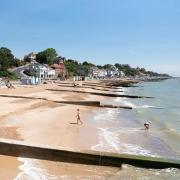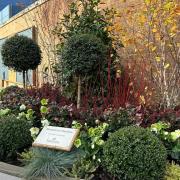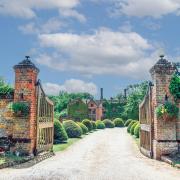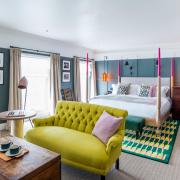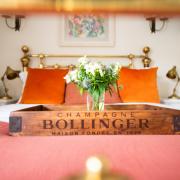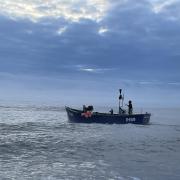A few years ago, I started doing my family history. It threw up all sorts.
A cousin I didn’t know about who emerged via DNA; a great great grandfather who lived in Crown Street and ran off with a woman from Chequer Square and lots of other little snippets, like the great grandfather who died in a London hotel on Boxing Day, and the great grandmother who married the lodger.
You pull on these strands and they hold you fast; rooted in a past that feels unfamiliar yet absolutely you at the same time. And all the strands and the people have one thing in common; they are all drawn back, time after time, generation after generation, to one little town – my town, Bury St Edmunds.
I grew up on Out Risbygate, number 46, opposite the Suffolk Regimental Museum. The view from my bedroom window allowed me to look out over at the barracks and I could see the old further education college, the swimming pool and the little paths and gullies where my brother John and I would ride our bikes.

We had ponies in the field behind our house which stretched as far as York Road, and a flat lawn where we played tennis and football with our neighbours, the Palmers, or set up showjumping competitions with old chairs and broomsticks for our hobby horses. There was an orchard where we picked apples and pears, and a yard where my parents ran their stone masonry business and a man called Malcolm fixed people’s cars.
An artist called Bryan parked his caravan in the field at one time and he painted our horses. Chickens roamed freely and we sold our own eggs and horse manure. To me, this was all entirely normal and boring. Now, it sounds perfect and, I feel today, that it was.
We never went far. We might nip to the shop for sweets – Howlett's on Queens Road or Herringtons on Risbygate Street, but this would be a great expedition. On Saturday mornings we played football over the Dip and took our sledges there when it snowed. We went to St Edmundsbury primary and crossed the road with Mrs Gallup, the lollipop lady, but Mum always came with us, pushing our baby brother in the pram.
At nine, we branched out and went to St James middle school on the other side of town. Only occasionally were we allowed to walk home alone through the Abbey Gardens and feed the ducks. Mainly, Mum would collect us from the Vinefields, always the last car to come up the hill – a large red Ford Granada estate, with our collie dog in the back. On the sports field, I won the 800 metres because Nadine Challenor, who was a much better runner than me, slowed down at the end. I streaked past her on the line and my grandfather said, ‘That’s my girl'. I have never known a greater moment of pride.

On Wednesdays and Saturdays, we would go to the market and buy fresh fruit and vegetables, wrapped up in brown bags that the seller would swing around by the corners to close them. We also shopped on the corner of Risbygate Street at Green’s, the grocer’s, and we’d get our meat from Dewhurst’s. Fish and chips from the Cracknell’s shop on St Andrew’s Street was the greatest treat on a Friday. We loved Mrs Cracknell, who lived next door to us. She was fond of our horses and would feed them over the fence.
At 13, I got a scholarship to Culford and started taking the bus from outside the dentist on Risbygate Street – not the one that’s there now, but the one on the other side of the road, now long gone. Mr Lee’s hands were a bit shaky but he made you feel safe. I don’t like going to the dentist now.
On the school bus, a boy asked me if I wanted to go for a ride with him. I said yes and everyone laughed. I thought he meant horses. I never took him up on it.
We rarely ate out. Everards was a great treat once a year for Sunday lunch and my mother would mark the last day of the school holidays with a trip to Purdy’s, latterly the Wimpy. Now, in Bury, there are 100 options for eating out. My boys like Cote and Pizza Express, or sometimes Byron Burger. Carluccios is much missed.

We didn’t want the Arc to come or the Apex, but now we wouldn’t be without them. I still like to ride the carousel when it visits. We miss Debenhams but I imagine Primark will do just as well. The Focus cinema was where I saw my first film, One Hundred and One Dalmatians. It became the Cornhill shopping centre, which also failed and now sits shyly next to McDonalds, awaiting its next incarnation.
The bus station went and so did the cattle market where we liked to go for the smells and sounds. But we still have the Abbeygate Cinema thanks to Pat Church and there aren’t many towns our size that can top that. Pat and his wife brought up all of us Bury kids. He lived his dream as he fuelled ours.
I miss the bookshops on Hatter Street where I spent many hours, then got my Bunty comics from Abbey News. Life was so simple then and now, as I grow older, it is becoming so again. I got married in May at Bury register office. Where else?
Our old garden is now covered in houses. The further education building is the sparkling West Suffolk College. The hospital is still much the same though we all moan about the cost of parking. The cemetery is crammed. There are Nices sprinkled liberally throughout. I visit them from time to time.

I left Bury at 18 for university and returned in my 40s to bring up my sons. Now they are almost grown and will leave Bury too before long, I expect. But just like all the generations of Nices and Kinseys and Cuttings and Mawsons, and all the many other names in my family tree, they will return.
Bury is no better nor worse than anywhere else, perhaps. But it has a memory on every corner. It is, and always will be, home.












